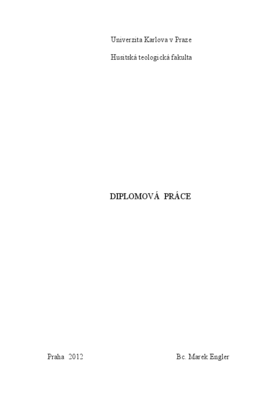Mikuláš Ludvík grof z Zinzendorfu a Hallský pietismus
Nicolaus Ludwik von Zinzendorf and Halle Pietism
Mikuláš Ludvík hrabě ze Zinzendorfu a Hallský pietismus
diploma thesis (DEFENDED)

View/
Permanent link
http://hdl.handle.net/20.500.11956/39877Identifiers
Study Information System: 114429
CU Caralogue: 990014795120106986
Collections
- Kvalifikační práce [2864]
Author
Advisor
Referee
Lášek, Jan Blahoslav
Faculty / Institute
Hussite Theological Faculty
Discipline
Hussite Theology
Department
Information is unavailable
Date of defense
23. 5. 2012
Publisher
Univerzita Karlova, Husitská teologická fakultaLanguage
Slovak
Grade
Excellent
Diplomová práca Gróf Zinzendorf a hallský pietizmus pojednáva o živote a diele grófa M.L. Zinzendorfa a jeho vzťahu k hallskému pietizmu. Prvá kapitola popisuje hospodársku, politickú a náboženskú situáciu vo vybraných nemeckých štátoch v r. 1650-1670. Druhá kapitola sa zaoberá vývojom v luterskej cirkvi, so zameraním na pietistické hnutie, jeho hlavných predstaviteľov a diela. Tretia kapitola je venovaná osobe M.L. Zinzendorfa, životu a teológii. Štvrtá kapitola mapuje založenie exulantskej kolónie Herrnhut a jej ďalší vývoj. Podkapitola 2.3. Pietizmus je podkladom pre analýzu vplyvov ktoré formovali grófa Zinzendorfa v jednotlivých obdobiach jeho života tak ako sú popísané v kapitole 3.
Diploma thesis Count Zinzendorf and Halle pietism deal with life and work of count Nicholas Ludwik von Zinzendorf and his relationship towards Halle pietism. First chapter describes economical, political and religious situation in selected german states in period 1650-1670. Second chapter deals with developement in Lutheran church, with main focus on pietistic movement and its leaders and their work. Third chapter describes personality of M.L. Zinzendorf, his life and theology. Fourth chapter is charting proces of estabilishing of settlement Herrnhut and its further developement. Sub-section 2.3. pietism is base for analysis of influences which forms count Zinzendorf in certain life periods as it is described in chapter 3.
